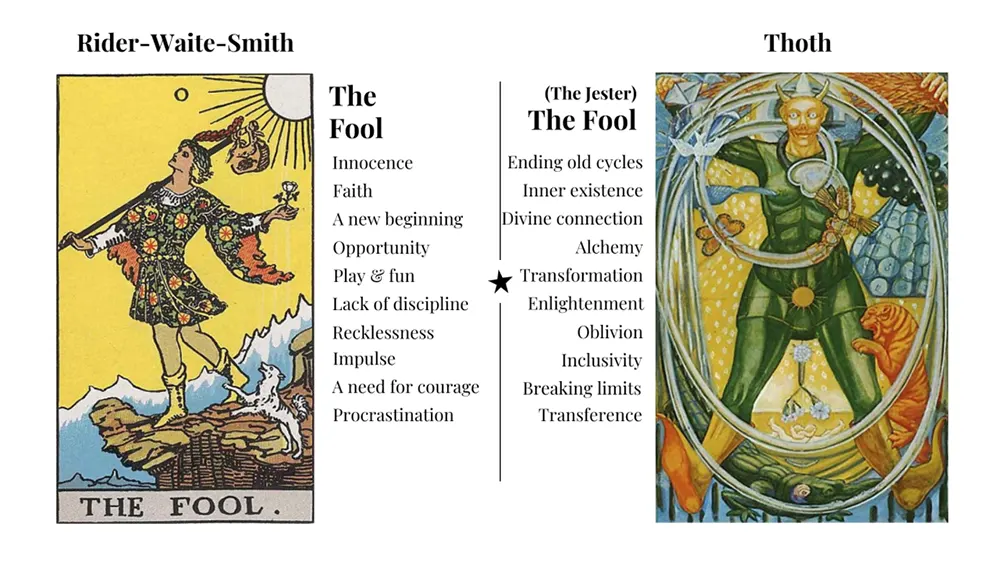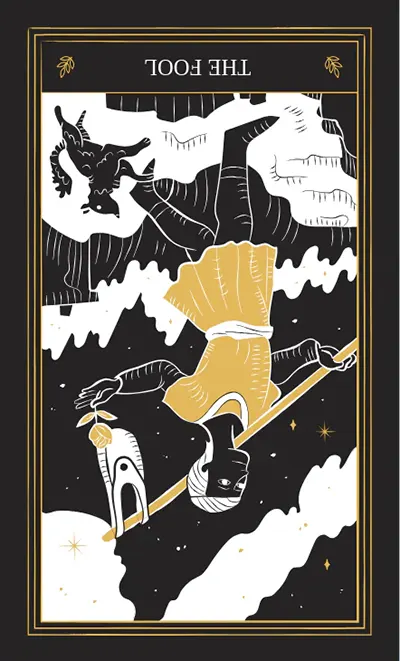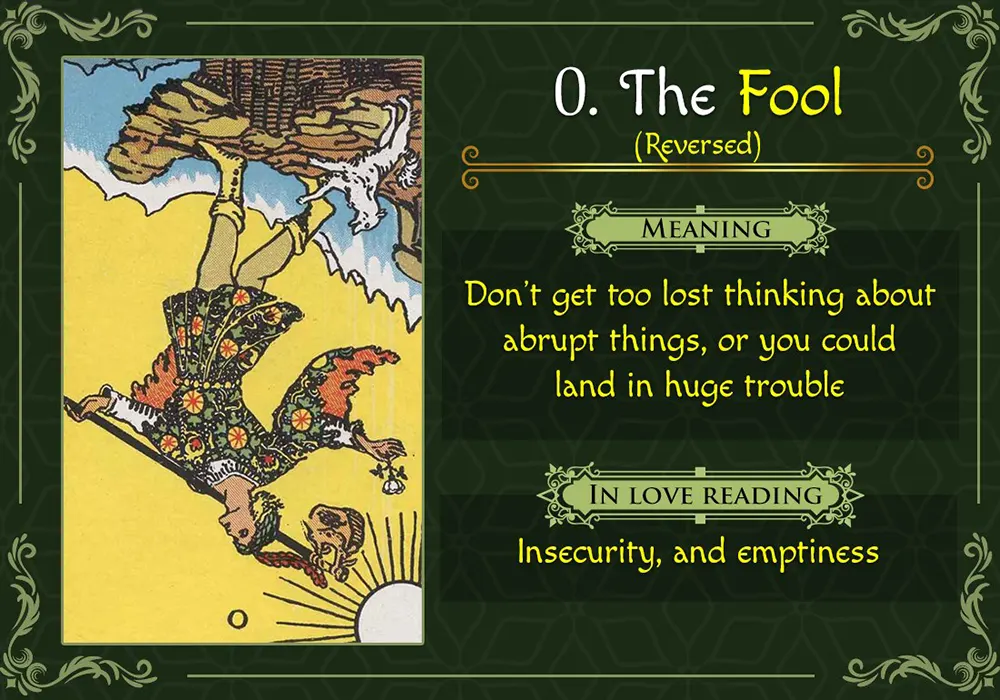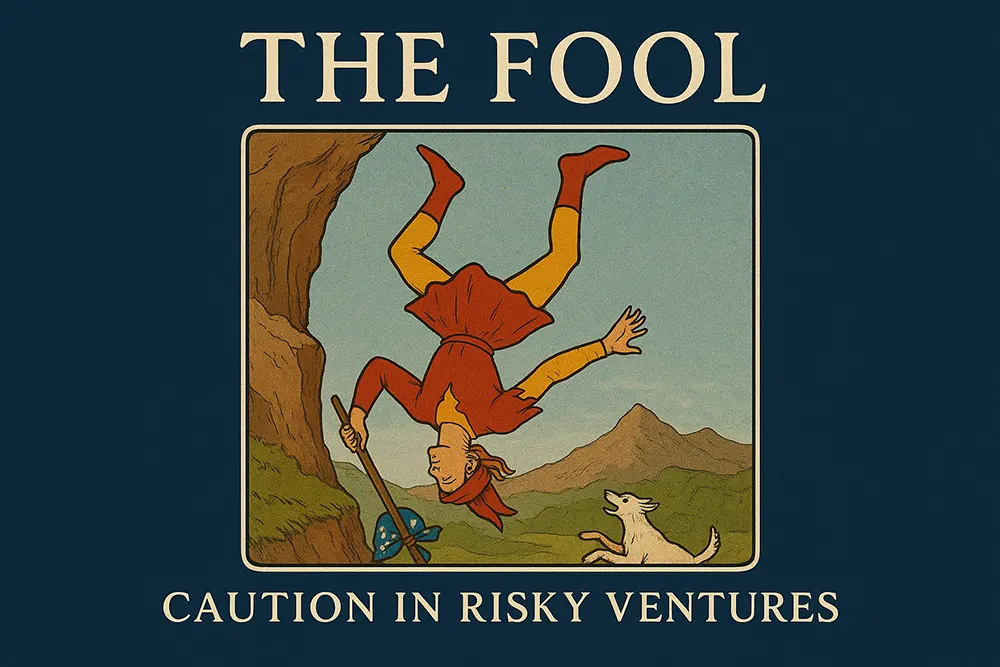In the mystical world of Tarot meanings, the Major Arcana holds profound insights into the human experience, and few cards capture the essence of adventure and uncertainty quite like The Fool. When this card appears reversed in a Tarot reading, it shifts from a symbol of boundless optimism to a gentle—or sometimes stern—reminder of caution in risky ventures. The Fool Reversed urges us to pause, reflect, and reassess before leaping into the unknown, highlighting themes of impulsiveness, hesitation, and the need for grounded decision-making. This card, often depicted as a carefree wanderer teetering on the edge of a cliff, inverts to suggest that blind faith might lead to unnecessary pitfalls.
But what does this mean for those exploring Tarot meanings in their daily lives? Whether you’re a seasoned Tarot reader or a newcomer drawn to the enigmatic Major Arcana reversed cards, understanding The Fool Reversed can provide clarity in moments of doubt. Interestingly, these themes of caution and risk echo in other divinatory practices, such as Palmistry, where the lines on our hands reveal innate tendencies toward boldness or prudence. In this comprehensive guide, we’ll delve deep into the Tarot meanings of The Fool Reversed, explore its implications across various life aspects, and draw parallels to Palmistry for a holistic perspective.

The Symbolism and History of The Fool in Tarot
To fully grasp the Tarot meanings of The Fool Reversed, it’s essential to start with the card’s origins and symbolism. The Fool is the zeroth card in the Major Arcana, representing the beginning of the spiritual journey through the Tarot’s archetypal path. In traditional decks like the Rider-Waite-Smith, The Fool is portrayed as a young traveler dressed in vibrant, motley attire, carrying a small knapsack on a stick over his shoulder. A loyal dog nips at his heels, and he’s about to step off a precipice, gazing upward with innocent wonder. The sun shines brightly, symbolizing enlightenment and new beginnings, while the white rose in his hand denotes purity and the mountains in the background signify challenges ahead.
Historically, The Fool draws from medieval jesters or fools in European folklore, who were often wise in their absurdity, speaking truths that others dared not. In Tarot, this archetype embodies innocence, spontaneity, and the leap of faith into uncharted territories. When upright, The Fool encourages embracing opportunities with childlike enthusiasm, trusting the universe to guide the way. However, in Major Arcana reversed positions, this energy inverts, transforming boundless potential into a warning against naivety.
The reversal doesn’t negate the card’s core essence but amplifies its shadow aspects. According to Tarot experts, The Fool Reversed often signals recklessness, poor judgment, or a fear of taking necessary risks. It might indicate that you’re rushing into something without proper preparation, or conversely, that hesitation is holding you back from growth. This duality makes it a fascinating card for introspection, prompting questions like: Are you being too impulsive, or are you paralyzed by overthinking?
In modern Tarot interpretations, The Fool Reversed aligns with psychological concepts such as the “shadow self” in Jungian theory, where unchecked impulses or repressed fears manifest. For instance, if you’re contemplating a major life change—like quitting a job to start a business—this card reversed might advise gathering more information before proceeding. It’s not about abandoning dreams but about approaching them with wisdom.
General Meaning of The Fool Reversed in Tarot Readings
Diving deeper into the Tarot meanings, The Fool Reversed in a general context emphasizes caution in risky ventures. It suggests that while new beginnings are on the horizon, proceeding without a plan could lead to setbacks. This card often appears when life feels chaotic, urging a return to basics: evaluate your goals, assess potential dangers, and build a safety net.
Key themes include:
- Impulsiveness and Recklessness: You might be tempted to act on a whim, ignoring red flags. The reversal warns that such behavior could result in avoidable mistakes, like investing in a dubious scheme or making hasty decisions in personal matters.
- Hesitation and Fear: On the flip side, The Fool Reversed can indicate procrastination or a fear of the unknown, keeping you stuck in familiar but unfulfilling patterns. It’s a call to balance optimism with realism.
- Lack of Preparation: This card highlights the importance of groundwork. Perhaps you’re embarking on a journey—literal or metaphorical—without the necessary tools or knowledge.
In daily Tarot readings, if The Fool Reversed pops up, reflect on recent choices. Have you been avoiding risks altogether, or diving in headfirst without looking? Real-life examples abound: a student switching majors impulsively might regret it later, or an entrepreneur delaying a launch due to perfectionism could miss opportunities.
To illustrate, consider a case study from Tarot communities: A querent drew The Fool Reversed when pondering a spontaneous move abroad. The card advised researching visas, finances, and cultural adjustments first, turning a potential disaster into a well-planned adventure.

The Fool Reversed in Love and Relationships
When it comes to love Tarot meanings, The Fool Reversed introduces a layer of complexity, often signaling caution in romantic risky ventures. In relationships, this card reversed might indicate that excitement is masking underlying issues, or that fear is preventing genuine connection.
For singles, The Fool Reversed suggests being wary of jumping into new romances without discernment. You could be attracted to someone who seems adventurous but is actually unreliable, leading to heartbreak. It advises taking time to know a potential partner, avoiding the pitfalls of infatuation-driven decisions. Conversely, if you’re hesitant to date due to past wounds, this card encourages gentle steps forward, not complete avoidance.
In committed relationships, The Fool Reversed can point to recklessness, such as infidelity or impulsive arguments that erode trust. It might also reveal a partner’s immaturity or your own reluctance to commit fully. For example, if planning a big step like marriage, this reversal urges practical discussions about finances and future goals to ensure stability.
Tarot readers often pair this with advice: Use The Fool Reversed as a prompt for open communication. Ask yourself or your partner: Are we being foolish in our assumptions, or wisely cautious? In twin flame or soulmate contexts, it warns against idealizing a connection without grounding it in reality.
Extending this to Palmistry, the Heart Line in your palm can mirror these themes. A broken or chained Heart Line might indicate emotional impulsiveness, akin to The Fool Reversed’s warning in love. Palmists interpret a faint Heart Line as hesitation in matters of the heart, suggesting a need for balance—much like the Tarot’s call for caution. By combining Tarot and Palmistry, you gain a multifaceted view: The Fool Reversed in a reading, coupled with a Palmistry analysis, could reveal innate tendencies toward romantic risks and how to navigate them wisely.
The Fool Reversed in Career and Finance
In career Tarot meanings, The Fool Reversed is a beacon for caution in professional risky ventures. It often appears when contemplating job changes, investments, or entrepreneurial pursuits, advising against leaps without parachutes.
For career transitions, this card reversed might signal that a new opportunity looks appealing but lacks substance. Perhaps you’re considering quitting without a backup plan, or starting a business impulsively. The message is clear: Research, network, and prepare. Tarot interpretations suggest this reversal highlights immaturity in decision-making, like accepting a role without negotiating salary or terms.
Financially, The Fool Reversed warns of speculative investments or spending sprees. It could indicate naivety in money matters, such as falling for get-rich-quick schemes. Instead, it promotes prudent planning—budgeting, saving, and seeking advice from experts. A real-world application: During economic uncertainty, this card might advise holding off on major purchases until stability returns.
Linking to Palmistry, the Fate Line (or Line of Destiny) on the palm often reflects career paths and life decisions. A fragmented Fate Line could parallel The Fool Reversed’s theme of disrupted journeys due to poor choices. Palmists note that a strong, unbroken Fate Line suggests calculated risks paying off, while interruptions warn of impulsiveness—echoing the Tarot’s reversal. Integrating these, a Tarot reading with The Fool Reversed might prompt a Palmistry check to see if your hand lines support bold moves or advocate caution.
In practice, use this card to brainstorm: List pros and cons of a career move, consult mentors, and align actions with long-term goals. Over time, this approach transforms potential follies into informed successes.
The Fool Reversed in Health and Wellness
Health Tarot meanings for The Fool Reversed emphasize caution in wellness-related risky ventures. This card might appear when ignoring bodily signals or engaging in extreme behaviors, urging a more balanced approach.
Physically, it could indicate accidents from carelessness, like sports injuries from overexertion without warm-ups. Mentally, it warns of burnout from pushing limits without rest. In wellness journeys, such as starting a new diet or exercise regime, The Fool Reversed advises consulting professionals to avoid harm.
Spiritually and emotionally, this reversal highlights the need for self-care amid chaos. If feeling overwhelmed, it suggests grounding practices like meditation to counteract impulsiveness. For those with chronic issues, it might signal delaying alternative treatments until researched thoroughly.
In Palmistry, the Life Line arcs around the thumb base, symbolizing vitality and life path. A short or broken Life Line doesn’t predict early death but may indicate health disruptions from risky behaviors—mirroring The Fool Reversed’s caution. A chained Life Line could suggest scattered energy, prompting lifestyle adjustments. By reading your palm alongside Tarot, you might uncover patterns: Does your Life Line show resilience, allowing for calculated risks, or fragility, demanding prudence?
Practical tips include journaling health goals, tracking habits, and seeking second opinions. The Fool Reversed reminds us that true wellness comes from mindful steps, not reckless bounds.

Spiritual Insights from The Fool Reversed
On a spiritual level, the Major Arcana reversed cards like The Fool offer profound lessons in growth. This reversal invites exploration of new paths but with discernment, warning against spiritual bypassing—ignoring practical realities in pursuit of enlightenment.
It might signal eagerness for new practices, like meditation retreats or esoteric studies, but without foundation, leading to confusion. The Fool Reversed encourages building spiritual routines gradually, integrating lessons from past experiences.
In Palmistry, the Head Line represents intellect and mindset, often linking to spiritual inclinations. A wavy Head Line might indicate fluctuating beliefs, akin to The Fool Reversed’s indecision. A straight line suggests logical caution, helping ground spiritual pursuits. Combining these, a Tarot spread with this card could be enhanced by Palmistry to assess if your mental lines support intuitive leaps or require structured learning.
Meditate on The Fool Reversed by visualizing the upright Fool’s journey inverted: What if the cliff represents internal fears? Use affirmations like “I embrace change with wisdom” to harness its energy.
Bridging Tarot and Palmistry: Parallel Themes of Caution
While Tarot provides narrative insights through cards, Palmistry offers a personal map via hand lines, and linking The Fool Reversed to Palmistry enriches both. In Palmistry, the Mount of Jupiter (under the index finger) governs ambition and risk-taking; a prominent mount might amplify The Fool’s adventurous spirit, but if underdeveloped, it echoes the reversal’s caution.
The Mercury Line (near the pinky) relates to communication and adaptability—weak lines could indicate hesitancy in ventures, paralleling Tarot warnings. Practitioners often use both systems: A Tarot reading showing The Fool Reversed might lead to examining the palm for confirming signs, like islands on lines denoting obstacles.
Historical texts on divination note overlaps; for instance, ancient chiromancy (Palmistry) and cartomancy (Tarot) both draw from esoteric traditions, emphasizing fate versus free will. By integrating them, you create a personalized divinatory toolkit, where The Fool Reversed’s message of caution becomes a cross-disciplinary guide.
Practical Applications and Card Combinations
In Tarot spreads, The Fool Reversed’s position matters. In the past, it might explain past follies; in the present, current indecision; in the future, potential pitfalls to avoid.
Common combinations:
- With The Tower: Sudden disruptions from risky choices.
- With The Hermit: Need for introspection before action.
- With The Chariot: Overcoming hesitation through determination.
For Palmistry synergy, compare readings: If Tarot shows reversal, check palm mounts for strengths to leverage.
Frequently Asked Questions (FAQs) about The Fool Reversed
What does The Fool Reversed mean in a yes or no Tarot reading?
In yes/no questions, The Fool Reversed leans toward “no” or “not yet,” advising caution and more preparation before proceeding.
How does The Fool Reversed differ from its upright meaning?
Upright, it’s about optimistic beginnings; reversed, it warns of recklessness or fear, emphasizing grounded approaches.
Can The Fool Reversed indicate positive outcomes?
Yes, if heeded as advice—it can lead to wiser decisions, turning potential mistakes into growth opportunities.
What if The Fool Reversed appears in a love reading?
It suggests evaluating relationships for impulsiveness or insecurity, promoting honest communication.
How can Palmistry complement The Fool Reversed in Tarot?
Palm lines like the Fate or Head Line can reveal innate traits of caution or risk, providing a tangible counterpart to Tarot’s symbolic warnings.
Is The Fool Reversed a bad card?
No Tarot card is inherently bad; it’s a mirror for reflection, highlighting areas needing attention.
What actions should I take if I draw The Fool Reversed?
Pause, plan, and seek advice—transform caution into empowered steps.
Conclusion: Embracing Wisdom in the Journey
The Fool Reversed in Tarot meanings serves as a vital reminder that while life’s adventures beckon, caution in risky ventures ensures sustainable progress. By understanding its nuances across love, career, health, and spirituality—and drawing parallels to Palmistry—we equip ourselves for mindful navigation. Whether through Tarot spreads or palm readings, this card invites us to blend innocence with insight, turning potential follies into triumphs. As you reflect on your own path, remember: The true fool is not the one who stumbles, but the one who refuses to learn from it. Explore further, and may your ventures be wisely bold.

Related Posts
The High Priestess: Unlocking Intuition and Hidden Mysteries
The Magician: Mastering Manifestation and Personal Power
Ace of Cups: Overflowing Emotions and New Love
The Fool: Embracing New Beginnings and Adventures in Tarot